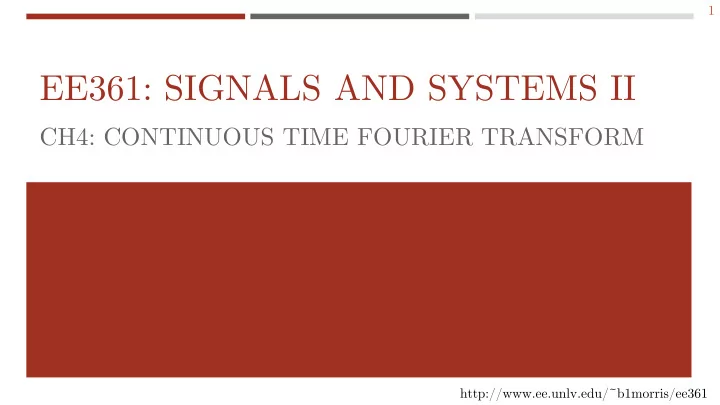

1 EE361: SIGNALS AND SYSTEMS II CH4: CONTINUOUS TIME FOURIER TRANSFORM http://www.ee.unlv.edu/~b1morris/ee361
2 FOURIER TRANSFORM DERIVATION CHAPTER 4.1
3 FOURIER SERIES REMINDER Previously, FS allowed representation of a periodic signal as a linear combination of harmonically related exponentials 1 𝑈 𝑦 𝑢 𝑓 −𝑘𝑙𝜕 0 𝑢 𝑒𝑢 𝑦 𝑢 = σ 𝑙 𝑏 𝑙 𝑓 𝑘𝑙𝜕 0 𝑢 𝑏 𝑙 = 𝑈 Would like to extend this (Transform Analysis) idea to aperiodic (non-periodic) signals
4 CT FOURIER TRANSFORM DERIVATION I Intuition: Consider a periodic signal with period 𝑈 Let 𝑈 → ∞ Infinite period no longer periodic signal 2𝜌 Results in 𝜕 0 = 𝑈 → 0 Zero frequency space between “harmonics” differential 𝑒𝜕 Envelope (like we saw with rectangle wave/sinc) defines the CTFT
5 CT FOURIER TRANSFORM DERIVATION II Will skip derivation for now Please see details in the book
6 CT FOURIER TRANSFORM PAIR ∞ 𝑌 𝑘𝜕 𝑓 𝑘𝜕𝑢 𝑒𝜕 1 synthesis eq (inverse FT) 𝑦 𝑢 = 2𝜌 −∞ ∞ 𝑦 𝑢 𝑓 −𝑘𝜕𝑢 𝑒𝑢 analysis eq (FT) 𝑌 𝑘𝜕 = −∞ Denote 𝑦 𝑢 ↔ 𝑌(𝑘𝜕) 𝑦 𝑢 = ℱ −1 𝑌 𝑘𝜕 𝑌 𝑘𝜕 = ℱ 𝑦 𝑢
7 CTFT CONVERGENCE There are conditions on signal 𝑦(𝑢) for FT to exist Finite energy (square integrable) ∞ 𝑦 𝑢 2 𝑒𝑢 < ∞ −∞ Dirichlet Conditions We will not cover; see pg 290 for more discussion
8 CTFT FOR PERIODIC SIGNALS CHAPTER 4.2
9 FT OF PERIODIC SIGNALS Derived FT by assuming a periodic padding of aperiodic signal 𝑦(𝑢) What happens for FT of a periodic signal? Note: periodic signal will not have finite energy Cannot evaluate FT integral directly
10 PERIODIC FT DERIVATION I From derivation of FT, 𝑌 𝑘𝜕 is the envelope of 𝑈𝑏 𝑙 FS coefficients are scaled samples of 𝑌 𝑘𝜕 Assume 𝑦(𝑢) is periodic 𝑦 𝑢 = 𝑦 𝑢 + 𝑈 2𝜌 ∞ Then, 𝑦 𝑢 = σ 𝑙=−∞ 𝑏 𝑙 𝑓 𝑘𝑙𝜕 0 𝑢 , with 𝜕 0 = 𝑈 Plug into FT integral and solve Will not solve for now on slides see book
11 PERIODIC FT DERIVATION II Important property 𝑦 𝑢 = 𝑓 𝑘𝑙𝜕 0 𝑢 ↔ 𝑌 𝑘𝜕 = 2𝜌𝜀 𝜕 − 𝑙𝜕 0 Transform pair 𝑏 𝑙 𝑓 𝑘𝑙𝜕 0 𝑢 ↔ 2𝜌 σ 𝑙=−∞ ∞ ∞ σ 𝑙=−∞ 𝑏 𝑙 𝜀 𝜕 − 𝑙𝜕 0 Each 𝑏 𝑙 coefficient gets turned into a delta at the harmonic frequency
12 FT OF SINUSOIDAL SIGNALS FT of periodic signals is important because of sinusoidal signals (cannot solve using FT integral) Can use insight of complex exponential ↔ shifted delta from periodic FT derivation Important examples
13 CTFT PROPERTIES AND PAIRS CHAPTER 4.3-4.6
14 PROPERTIES TABLE 4.1 (PG 328) Linearity Time scaling 𝑦 𝑢 ↔ 𝑌(𝑘𝜕) 1 𝑘𝜕 𝑦 𝑏𝑢 ↔ 𝑏 𝑌 𝑧 𝑢 ↔ 𝑍 𝑘𝜕 𝑏 Differentiation in time 𝑏𝑦 𝑢 + 𝑐𝑧 𝑢 ↔ 𝑏𝑌 𝑘𝜕 + 𝑐𝑍 𝑘𝜕 Time shifting 𝑒𝑦 𝑢 ↔ 𝑘𝜕𝑌(𝑘𝜕) 𝑒𝑢 𝑦 𝑢 − 𝑢 0 ↔ 𝑓 −𝑘𝜕𝑢 0 𝑌(𝑘𝜕) Integration in time Note, this is a phase shift of 𝑌 𝑘𝜕 Conjugation 𝑢 1 𝑦 𝜐 𝑒𝜐 ↔ 𝑘𝜕 𝑌 𝑘𝜕 + −∞ 𝑦 ∗ 𝑢 ↔ 𝑌 ∗ −𝑘𝜕 𝜌𝑌 0 𝜀 𝜕 Remember: conjugation switches sign of imaginary part
15 CONVOLUTION/MULTIPLICATION PROPERTIES Convolution 𝑧 𝑢 = ℎ 𝑢 ∗ 𝑦 𝑢 ↔ 𝑍 𝑘𝜕 = 𝐼 𝑘𝜕 𝑌 𝑘𝜕 Multiplication ∞ 𝑇 𝑘𝜄 𝑄 𝑘 𝜕 − 𝜄 1 𝑠 𝑢 = 𝑡 𝑢 𝑞 𝑢 ↔ 𝑆 𝑘𝜕 = 𝑒𝜄 2𝜌 −∞ 1 𝑆 𝑘𝜕 = 2𝜌 𝑇 𝑘𝜕 ∗ 𝑄 𝑘𝜕 Dual properties – convolution ↔ multiplication
16 FT PAIRS TABLE 4.2 (PG 329) Be sure to bookmark this table (right next to Table 4.1 Properties) Note in particular some very useful pairs that aren’t typical 1 𝑢𝑓 −𝑏𝑢 𝑣 𝑢 ↔ repeated root 𝑏+𝑘𝜕 2 1 𝑣 𝑢 ↔ 𝑘𝜕 + 𝜌𝜀(𝜕)
17 CTFT AND LTI SYSTEMS CHAPTER 4.7
18 FIRST-ORDER EXAMPLE Find impulse response ℎ(𝑢)
19 LTI SYSTEM ANALYSIS Note for 𝐼 𝑘𝜕 to exist, the LTI system must have impulse response ℎ(𝑢) that satisfies stability conditions FT is only for the analysis of stable LTI systems For not stable systems, use Laplace Transform in Ch9
20 GENERAL DIFFERENTIAL EQUATION SYSTEM Solve for frequency response Take FT of both sides Rational form – ratio of polynomials in 𝑘𝜕 Best solved using partial fraction expansion (Appendix A)
Recommend
More recommend